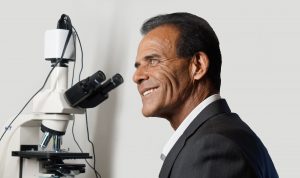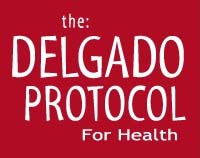 Hormonal balance is vital to a healthy, cancer-free body and mind, but most adults past 30 have at least one hormone deficiency. Allopathic doctors typically prescribe Hormone Replacement Therapy (HRT) for hormone imbalances. This is not ideal however, because the hormones prescribed are artificial and unnatural to the body. They also cause a myriad of negative side-effects, and can increase the risk for cancer, dementia, stroke, heart attack and urinary incontinence (to name a few).[i] Fortunately, you can restore hormonal balance both safely and naturally with dietary modifications and plant-based therapies.
Hormonal balance is vital to a healthy, cancer-free body and mind, but most adults past 30 have at least one hormone deficiency. Allopathic doctors typically prescribe Hormone Replacement Therapy (HRT) for hormone imbalances. This is not ideal however, because the hormones prescribed are artificial and unnatural to the body. They also cause a myriad of negative side-effects, and can increase the risk for cancer, dementia, stroke, heart attack and urinary incontinence (to name a few).[i] Fortunately, you can restore hormonal balance both safely and naturally with dietary modifications and plant-based therapies.
The Hormone Balancing Diet
The Standard American Diet (SAD) wreaks havoc on your health and can lead to all kinds of hormonal imbalances. Simply improving your diet can help to produce at least a 30 improvement in hormonal balance. Ideally, you should consume a plant-based diet, that includes plenty of fresh fruits and vegetables, and is rounded out with beans and legumes, wholegrains, nuts and seeds. Animal products should be avoided, and the consumption of sugar, caffeine, processed and packaged foods should be limited.
Top 3 Hormone Deficiencies and How to Restore Them Naturally
If a hormone imbalance is already present, dietary changes alone will not be enough. Combining the above diet with nutrient and plant-based therapy however, can produce dramatic hormone balancing results.
Estrogen
Levels of estrogen decline rapidly as a woman approaches menopause and many menopausal symptoms can be avoided by restoring estrogen levels. An estrogen deficiency is not just limited to menopausal women however; it can occur in men and women of all ages (although too much estrogen is a more common problem in the US). Symptoms that can indicate an estrogen deficiency include: loss of libido, increased body fat, bone loss, joint pain, dark undereye circles, headaches, fatigue, anxiety, irritability, depression, and trouble sleeping. In men it can cause a loss of erections or penile sensitivity, and in women it can cause painful sex, UTIs, irregular periods, and/or breast tenderness. [ii][iii]
Plant-Based Therapy
Phytoestrogens are plant-derived compounds that mimic the effects of estrogen in the body.[iv] Black cohosh is one well-studied phytoestrogen that is used widely in Europe as an alternative to HRT, for the treatment of hot flashes and other menopausal symptoms. Red clover is another common estrogen booster; it helps to cleanse and strengthen the liver so that it can regulate estrogen production, and it’s highly effective at reducing menopausal symptoms.[v][vi] Additional herbs that help to naturally boost estrogen levels include: dong quai, ginseng, ashwagandha, and evening primrose oil.
Progesterone
Progesterone is often thought of as a female sex-hormone, but both genders require it for optimal health. Progesterone helps to balance out the negative effects of too much estrogen, which is beneficial because estrogen dominance is an extremely common condition that wreaks havoc on your mental and physical health. Stress, excessive exercise, and an overexposure to environmental estrogen-like compounds (xenoestrogens) can all lead to a progesterone deficiency. Women with low progesterone may experience irregular menstruation, severe cramps, mid-cycle spotting, Polycystic Ovarian Syndrome (PCOS), fertility issues, and/or an inability to carry a pregnancy to term. Symptoms of low progesterone that apply to both men and women include: a loss of energy and sex drive, depression, anxiety, reduced metabolism, acne, dry skin, brittle nails, joint pain, and an increased risk for osteoporosis.
Plant-Based Therapy
Chastetree berry (vitex) helps to boost luteinizing hormone levels during the luteal phase of a woman’s menstrual cycle, which increases the production of progesterone.[vii] Maca is a nutrient-rich Peruvian herb that helps to regulate the production of estrogen, testosterone and progesterone, and promotes a healthy balance of all three. Diindolylmethane, or DIM, is a nutrient that is derived from cruciferous vegetables, and it helps offset the negative effects of low progesterone by reducing estrogen levels. This is important because the two hormones need to be maintained in a delicate balance and if estrogen is too high you will experience symptoms of low progesterone, even if your progesterone levels are in the normal range.
*EstroBlock is a physician formulated supplement with a clinically effective dose of DIM
Testosterone
Testosterone is another sex hormone that both males and females require. At least one in four men aged 30+ are estimated to have low testosterone levels, which is defined as 300ng/dL of total testosterone and less than 5 ng/dL of free testosterone.[viii] The symptoms of low testosterone in men include changes in sleep patterns, loss of libido, sexual dysfunction, infertility, muscle loss, weight gain, fatigue, depression, and emotional changes.[ix] By the time a woman reaches 40 her testosterone levels are half of what they were at 20. If testosterone levels drop too low, a woman may experience symptoms such as a loss of libido, difficulty reaching orgasm, lethargy, muscle weakness, depression, and a decreased sense of wellbeing.[x]
Plant-Based Therapy
Nettle root increases the availability of free-form testosterone. One study found that when combined with oat straw extract, the testosterone levels of men and women participating in the experiment increased by an average of 105. Rhodiola is another effective herb for boosting testosterone — a clinical investigation found that 2 grams of rhodiola crenulate taken for a month resulted in a 76 increase in testosterone. Zinc is also helpful, especially in males who are deficient in it; and both magnesium and boron can help to increase free testosterone levels. TestroVida contains nettle root, oat straw, zinc, and boron and it safely and effectively boosts testosterone levels in both genders.
[ytp_video source=”8CDKApKHZa8″][i] https://www.cancer.gov/about-cancer/causes-prevention/risk/hormones/mht-fact-sheet
[ii] https://dosagemayvary.com/high-estrogen-vs-low-estrogen-symptoms-for-men/
[iii] https://www.healthline.com/health/womens-health/low-estrogen-symptoms#symptoms2
[iv] https://www.ncbi.nlm.nih.gov/pmc/articles/PMC3074428/
[v] https://www.ncbi.nlm.nih.gov/pmc/articles/PMC4678495/
[vi] http://www.umm.edu/health/medical/altmed/herb/red-clover
[vii] http://www.aafp.org/afp/2005/0901/p821.html
[viii] http://abcnews.go.com/Health/Healthday/story?id=4508669&page=1
[ix] https://www.ncbi.nlm.nih.gov/pmc/articles/PMC2544367/
[x] https://academic.oup.com/humupd/article/10/5/421/769528



